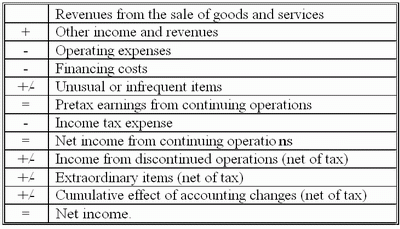Do you want BuboFlash to help you learning these things? Or do you want to add or correct something? Click here to log in or create user.
#analyst-notes #cfa-level-1 #fra-introduction #has-images #reading-22-financial-statement-analysis-intro #study-session-7
Income Statement

The income statement summarizes revenues earned and expenses incurred, and thus measures the success of business operations for a given period of time. It explains some but not all of the changes in the assets, liabilities, and equity of the company between two consecutive balance sheet dates.
The income statement lists income and expenses as they are directly related to the company's recurring income. The format of the income statement is not specified by U.S. GAAP and actual format varies across companies. The following is a generic sample:

The goal of income statement analysis is to derive an effective measure of future earnings and cash flows. Analysts need data with predictive ability, hence income from continuing (recurring) operations is considered to be the best indicator of future earnings. As operating expenses do not include financing costs such as interest expenses, operating income (EBIT) is independent of the company's capital structure.
In the typical income statement this means segregating the results of normal, recurring operations from the effects of nonrecurring or extraordinary items to improve the forecasting of future earnings and cash flows. The idea here is that recurring income is persistent. If an item in the unusual or infrequent component of income from continuing operations is deemed not to be persistent, then recurring (pre-tax) income from continuing operations should be adjusted.
The net income figure is used to prepare the statement of retained earnings.
If you want to change selection, open document below and click on "Move attachment"
Subject 2. Major Financial Statements
four financial statements, augmented by footnotes and supplementary data, are interrelated. In addition, there are other sources of financial information, such as management discussion and analysis, auditor's reports, etc. <span>Income Statement The income statement summarizes revenues earned and expenses incurred, and thus measures the success of business operations for a given period of time. It explains some but not all of the changes in the assets, liabilities, and equity of the company between two consecutive balance sheet dates. The income statement lists income and expenses as they are directly related to the company's recurring income. The format of the income statement is not specified by U.S. GAAP and actual format varies across companies. The following is a generic sample: The goal of income statement analysis is to derive an effective measure of future earnings and cash flows. Analysts need data with predictive ability, hence income from continuing (recurring) operations is considered to be the best indicator of future earnings. As operating expenses do not include financing costs such as interest expenses, operating income (EBIT) is independent of the company's capital structure. In the typical income statement this means segregating the results of normal, recurring operations from the effects of nonrecurring or extraordinary items to improve the forecasting of future earnings and cash flows. The idea here is that recurring income is persistent. If an item in the unusual or infrequent component of income from continuing operations is deemed not to be persistent, then recurring (pre-tax) income from continuing operations should be adjusted. The net income figure is used to prepare the statement of retained earnings. Balance Sheet A balance sheet provides a "snapshot" of a company's financial condition. Think of the balance sheet as a photo of the bu
Subject 2. Major Financial Statements
four financial statements, augmented by footnotes and supplementary data, are interrelated. In addition, there are other sources of financial information, such as management discussion and analysis, auditor's reports, etc. <span>Income Statement The income statement summarizes revenues earned and expenses incurred, and thus measures the success of business operations for a given period of time. It explains some but not all of the changes in the assets, liabilities, and equity of the company between two consecutive balance sheet dates. The income statement lists income and expenses as they are directly related to the company's recurring income. The format of the income statement is not specified by U.S. GAAP and actual format varies across companies. The following is a generic sample: The goal of income statement analysis is to derive an effective measure of future earnings and cash flows. Analysts need data with predictive ability, hence income from continuing (recurring) operations is considered to be the best indicator of future earnings. As operating expenses do not include financing costs such as interest expenses, operating income (EBIT) is independent of the company's capital structure. In the typical income statement this means segregating the results of normal, recurring operations from the effects of nonrecurring or extraordinary items to improve the forecasting of future earnings and cash flows. The idea here is that recurring income is persistent. If an item in the unusual or infrequent component of income from continuing operations is deemed not to be persistent, then recurring (pre-tax) income from continuing operations should be adjusted. The net income figure is used to prepare the statement of retained earnings. Balance Sheet A balance sheet provides a "snapshot" of a company's financial condition. Think of the balance sheet as a photo of the bu
Summary
| status | not read | reprioritisations | ||
|---|---|---|---|---|
| last reprioritisation on | suggested re-reading day | |||
| started reading on | finished reading on |
Details
Discussion
Do you want to join discussion? Click here to log in or create user.